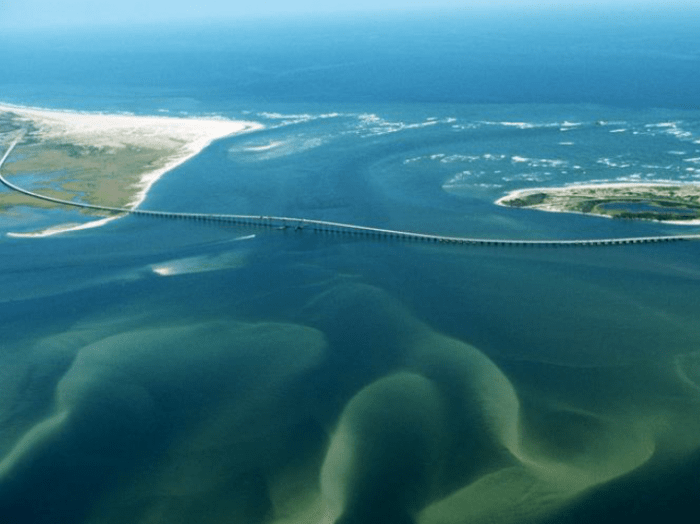Murphy Says Jetties Needed at Oregon Inlet

As Oregon Inlet continues to thwart nearly every effort to tame it, North Carolina Congressman Greg Murphy, a Republican from Greenville, is lending his voice to reviving pursuit of twin jetties to prevent sand clogging the inlet’s navigation channel.
“What we need to do is we need have the jetties built,” Murphy said at a brief press gathering Friday after touring Wanchese Marine Industrial Park. “That will be the fix.”
Despite being the subject of 40 years of battles from Manteo to Washington, D.C., the controversial Oregon Inlet jetty project was finally killed off in 2003 by the White House Council on Environmental Quality after a report the prior year that described economic and environmental concerns as unresolved. But it has since transformed into a mythical zombie, its huge shadow looming over frustrated attempts to harness the channel.

During a brief interview at the marine park office, Murphy explained that he had met several times with the Oregon Inlet Task Force Chair Jim Tobin, also a member of the Dare County Board of Commissioners, who had taken him to see the conditions in Oregon Inlet for himself.
The inlet, the only opening from sound to ocean between Virginia and Hatteras, has been badly shoaled from recent storms, making it hazardous for fishing vessels and charter boats to navigate. The authorized depth of the navigation channel is 14 feet, although the U.S. Army Corps of Engineers has had difficulty maintaining the channel to that specification. With the new Basnight Bridge having multiple high spans, there is now flexibility to re-mark the navigational channel to follow best water, but shoaling persists.
Dredging, which can be costly and difficult to schedule, has not been able to keep up with maintenance needs.
“We’re putting good money after bad,” Murphy said.
The design of the proposed jetty project includes one, 2-mile-long jetty on the north side of the channel and a 3,500-foot-long jetty that would be attached to the existing half-mile-long south terminal groin. The project also would include a sand-bypass system to promote sand movement and prevent beach erosion.
Murphy said there’s an “exceedingly good economic argument” for the jetty project.
But for now, with dredging the only available solution to keep the channels open, he said he found more money to help. In February, Murphy submitted a special request for an additional $1.3 million from the Army Corps of Engineers to do more work in Oregon Inlet, Silver Lake Harbor, and New River Inlet, according to a press release.
“Dredging is an indispensable and critical service to eastern North Carolina’s commercial and recreational fishing industries,” Murphy said in the statement. “Livelihoods as well as our national defense depend upon navigable waters in the Third District.”
The congressman won a special election in 2019 to replace Rep. Walter Jones, who had represented the district for 25 years until his death in February 2019. Murphy was reelected to a full, two-year term in 2020.
Although he was not specific, Murphy said it was “suggested” that he visit the marine park, which opened in 1981, except then it was known as the “Seafood Park.” Originally, the park was supposed to be a hub for commercial seafood industries with trawlers moving local catch from the harbor out through Oregon Inlet to the ocean. But Oregon Inlet proved too unpredictable and difficult to maintain the channel depth required for the huge trawlers. Before long, most of the trawler fleet relocated to deeper ports, and by the mid-1990s, the park started its transformation to a premier boatbuilding location.
“It’s an amazingly well-run, well-equipped facility that’s not only known in North Carolina, but internationally,” Murphy said. “This is a gem for eastern North Carolina.”
Oregon Inlet, as legend has it, was named for the first ship that navigated through it — and promptly struck a shoal — after the inlet was carved out by a vicious hurricane in 1846. Ever since, the inlet has moved steadily to the south, at a rate of as much as 100 feet a year. Known for its powerful currents and fickle conditions, Oregon Inlet is regarded by coastal scientists and mariners as one of the most dynamic inlets on the East Coast.
In the brief time that Murphy made himself available Friday, he did not elaborate on what he would do to support the jetties.
In January, state Sens. Bob Steinburg, R-Chowan, and Michael Lazzara, R-Onslow, introduced Senate Bill 26. The one-page bill, “An Act to Clarify That A Terminal Groin Is Not An Erosion Control Structure And Therefore Is Not Subject To Limitations On Those Structures,” strikes out the words, “A ‘terminal groin’ is not a jetty.”
Rep. Bobby Hanig, R-Currituck, introduced a companion bill in the House. Hanig told Coastal Review in January that the measure was “a first step” to restart legislative action on the inlet and changes to the bill were possible.
As of Wednesday, both measures were still in committee, where they’ve been since early February.
Steinburg did not respond to multiple messages for comment and information about the bill.
“I stand ready to help in any way I can at the federal level.”— Rep. Greg Murphy, R-N.C.
Murphy said a jetty at Oregon Inlet would improve navigation.
“I am supportive of the effort in the North Carolina General Assembly spearheaded by Rep. Hanig and Sen. Steinberg to clear the path for this to become a reality. The inlet would continue to need further dredging, but I stand ready to help in any way I can at the federal level,” Murphy said Tuesday in an emailed statement his office provided in response to Coastal Review’s query.
Harry Schiffman, the vice-chairman of the Oregon Inlet Task Force, said in interview that he did not know the impetus for the bill in the North Carolina General Assembly. The task force was not aware of the legislation, he added, nor did it ask for it.
“My feeling was, well, there’s a lot of history out there on the meaning of these names,” he said.
In short, groins protect property, jetties protect channels.
At Oregon Inlet, a terminal groin — a structure built at the end of a piece of land — was built on the south side to protect the Bonner Bridge and N.C. 12 from erosion. Over time, sand built up — about 60 acres —behind the rock wall.
“So, it was very successful in what it was intended to do,” Schiffman said.
But Schiffman, who has spent his lifetime navigating Oregon Inlet, knows better than most how difficult it would be to not only get approval for the twin jetties, but to get the funding to build them.
The immediate hurdle is the fact that the U.S. Department of the Interior owns the land.
“The first thing that would have to happen is that the state would have to get control of both sides of the inlet because the DOI has always opposed the jetties,” he said. “Then you’d have to reengineer the project and there would have to be environmental assessments. All of that would have to be ramped up.”
Watermen started lobbying in the early 1960s for the twin jetties, which they argue would block sand from entering the inlet channel. In 1970, Congress approved the $108 million jetty project, but failed to fund it. But for the next 33 years, the lobbying continued, with proponents, including Schiffman, saying it would create jobs, save lives and allow for the inlet to be able to safely flush.
Environmentalists and scientists said it would harm fisheries and worsen erosion.
In 2013, the state created a task force to study acquisition of the inlet. But the effort fell flat, in large part because the federal government was not interested in trading or selling its land.
Schiffman said he believes the current plan that is underway to build a private-public dredge to maintain Oregon and Hatteras inlets is the most realistic option to maintain the waterways. The Oregon Inlet jetty project would be a much heavier lift.
“What kind of success we would, I don’t know,” he said. “I’m scarred and worn-out on that one. So, if (the dredge) fails, then only thing left is the jetties. And somebody else is going to have to fight that battle.”












